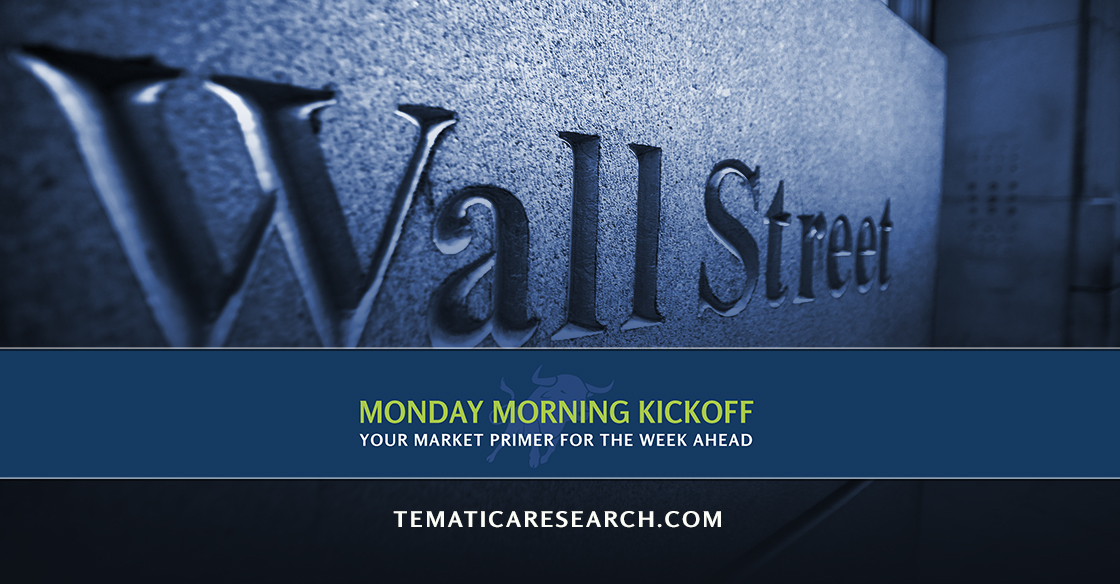Amazon and Wal-Mart Encroaching Onto Each Other’s Turf
DOWNLOAD THIS WEEK’S ISSUE
The full content of The Monday Morning Kickoff is below; however downloading the full issue provides detailed performance tables and charts. Click here to download.
Last week one was that can be best described as having many twists and turns from beginning to end. Going in, regular readers of the Monday Morning Kickoff knew that between the recent market moves, inflation and Retail Sales reports, the Fed, oil prices, and President Trump it was going to be a complicated week.
Few, however, foresaw Friday’s news that Amazon (AMZN) would acquire Whole Foods Market (WFM). That event dominated headlines as the week wrapped, and rightfully so as in our view the acquisition positions Amazon to disrupt the grocery industry like it has a number of others and puts it solidly in our Food with Integrity investing theme. Investors reacting to the news sent shares of big-box retailers like Wal-Mart (WMT), Costco (COST), and Target (TGT) lower on Friday.
Friday also saw Wal-Mart look to move deeper into our Connected Society investment theme on Friday with its announced acquisition of internet clothing brand Bonobos. The move comes as Wal-Mart looks to expand its online offering further after acquiring women’s retailer ModCloth, outdoor gear supplier Moosejaw and ShoeBuy. Given Bonobos’s reputation for high-quality clothing and “better fit”, we see it as a part of Wal-Mart’s desire to swim upstream in the apparel market, and not sell Bonobos clothing on Walmart’s website or stores, but on Jet.com, the online marketplace Walmart recently bought for $3 billion.
Odds are rather high we’ll share far more about those two transactions and what they mean for Kroger (KR), Sprouts Farmers Market (SFM), Target (TGT), Macy’s (M), Nordstrom (JWN) and other retailers on this week’s Cocktail Investing Podcast. We’ll also likely share why we don’t see Costco being as hard hit as many that run with the herd do. If you missed last week’s podcast, we chatted with Ted Cardenas, Senior Vice President of Marketing, Car Electronics Division at Pioneer Electronics Corp. about why and how it sees the Connected Car merging with the autonomous driving, or as we say one aspect of our Connected Society investing theme merging with another from our Disruptive Technologies investing theme.
Tech Stocks Draining on the Market
Last week the tech-heavy Nasdaq Composite Index shed just under 1 percent, while the Dow Jones Industrial Average edged higher and the S&P 500 remained largely unchanged. The disparity between the three indices was led by the wane in investor appetite for tech stocks, especially Facebook (FB), Apple (AAPL), Amazon (AMZN), Microsoft (MSFT) and Alphabet (GOOGL) in particular.
Here’s the deal when it comes to tech stocks — according to Barron’s, Facebook, Apple, Amazon, Microsoft and Alphabet combined account for about 56 percent of the $1.16 trillion gain in the NASDAQ 100 market cap since the start of the year. Outside of that index, the same stocks are also responsible for around 40 percent of the gain in the S&P 500 year-to-date. Collectively they trading near a P/E ratio of 39x on expected 2017 earnings, up 7 multiple points since the start of the year. Think about it – a 22 percent increase in the multiple in less than six months.
We’re not ones to look a gift horse in the mouth — we’ve profited handsomely from a couple of these tech stocks on the Tematica Select List — but with 32 percent of actively managed funds overweight the tech sector and 71 percent of actively managed funds are overweight FB, AAPL, AMZN, MSFT and GOOGL, we could see “tech” related headwinds over the coming weeks. While we may not enjoy that in the short-term, we’ll continue to follow the multi-year tailwinds that power our investment themes.
The Fed Puts Another Arrow Back in its Quiver
As we pretty much all know by now, the Federal Reserve boosted interest rates higher last week by a quarter point – it’s third increase in 18 months. Given it was a widely expected event, it was largely a non-event save for two factors. First, the Fed reiterated the likelihood of additional rate hikes down the road – business as usual for a Fed that needs to get as many policy arrows back in the quiver ahead of the next eventual recession. Don’t be alarmed, we talked about this in last week’s Monday Morning Kickoff – while there is no sign of a recession as yet, we are acknowledging that at some point one will happen.
What did turn heads, however, was Janet Yellen’s commentary over the tone of the domestic economy when she said, “The economy is doing very well, is showing resilience.”
Pardon us while we roll our eyes, and wonder if Janet Yellen has been looking at the same data we have? This week’s May inflation data, Retail Sales, Industrial Production and Housing Starts reports were all on balance weaker than expected. Plus we had the hard roll over in the Citigroup Economic Surprise Index. Those data points led the Atlanta Fed to cut its 2Q GDP forecast to 2.9 percent from 4 percent on May 1. Based on what we’re seeing, we suspect additional downside to be had as we get more June data in the coming weeks, and odds are that’s a speed that will be with us over the next several months.
What’s even more confounding in Janet Yellen’s statement is that alongside Wednesday’s rate hike, the Fed updated its long-run growth forecast, which doesn’t show any revving up in the economy. In reviewing its long-run growth forecast, the Fed expects the economy to remain at sub-2 percent growth, a place it has been at or near for the past decade. As we discussed in the last few issues of Tematica Insights (our premium product for institutional traders and fund managers) there are several structural headwinds that are and will continue to hold the speed of the US economy in check.
But let’s remember something about the Fed saying one thing, but doing another — it tends to be a cheerleader for the economy. Think of it this way, if the Fed is negative on the economy it pretty much becomes a self-fulfilling prophecy. Therefore, when it comes to monetary policy actions, we hear what Janet says, but we listen to the data and it seems we’re not alone. Despite the Fed’s call for a third rate hike later this year, the implied probability of a December rate hike per fed funds futures sits at 43.4 percent, down from last week’s 51.7 percent. Reading those same futures, the next rate-hike announcement is expected to come at the March 2018 FOMC meeting with an implied probability of 50.8 percent.
The Fed also laid out a specific plan for how it will start to normalize its balance sheet and Tematica’s Chief Macro Strategist Lenore Hawkins will be tackling this in an upcoming issue of Tematica Insights. The down and dirty is it’s not likely to have the impact many think it will but more on that at another time.
One Final Thought on the Fed’s Interest Rate Hike
Given the high levels of consumer debt across credit cards, auto loans and student debt, we could see this week’s rate hike put a crimp on consumer spending, which has been more fueled by debt rather than wage gains. For those that may have missed it, real average hourly earnings in the U.S. increased all of 0.6 percent, seasonally adjusted, from May 2016 to May 2017. As we say this, we feel the need to remind readers that directly and indirectly, the consumer accounts for roughly two-thirds of the economy. Headwinds to consumer spending equate to GDP headwinds.
One other topic that we’ve been getting more stoked up about is deflation. With that in mind, last week WTI crude settled the week with a loss of 2.4 percent. The move lower followed a bearish Energy Information Administration inventory report last Wednesday, which showed a smaller than expected draw of 1.7 million barrels (consensus -2.5 million barrels) in crude stocks and a buildup of 2.1 million barrels in gasoline inventories for the week ended May 9.
The week’s fall left the Texas Tea at its worst level since early November. The silver lining is we are seeing gas prices inch lower at a time when they normally are headed in the opposite direction as we reach the heavy driving, summer vacation time. Before we get too excited from mainstream media touting the positive economic impact of falling gas prices, the incremental savings equate to something more than a monthly pizza. Good for Domino’s (DPZ) or Papa John’s (PZZA), but not quite the huge boost to GDP one might think.
Turning to the Week Ahead
With the start of today’s market trading, there are 10 trading days left in the quarter, which means companies are on the cusp of entering their quiet periods, and before too long we’ll get any and all negative earnings preannouncements. As we get more June economic data and those preannouncements, barring any new Washington related issues, the points of focus for the market will be June quarter earnings and GDP expectations as well as EPS expectations for the second half of the year. Given the current vector and velocity of the economy and the Trump Slump, odds are those revisions will be downward in nature.
Let’s turn our gaze to this week; in doing so we see a rather light economic data week following this week’s ample figures and happenings. Aside from the usual weekly data, we have May Existing and New Home Sales reports as well as the FHFA Housing Price Index. Given the Fed’s boost in interest rates this week, we’ll be keeping closer tabs on the weekly MBA Mortgage Purchasing Index to see what’s likely ahead for the housing market and its economic ripple effect.
Much like last week, with few and far between earnings reports, we have a bevy of conferences and other investor events being held next week. Here are the ones will be watching, and the ETFs that are likely to be affected:
- Oppenheimer 17th Annual Consumer Conference 2017 – Consumer Discretionary Select Sector SPDR Fund (XLY)
- Jefferies Global Consumer Conference 2017 – iShares Global Consumer Discretionary ETF (RXI).
- University of California 2017 Information Security Symposium – PureFunds ISE Cyber Security ETF (HACK)
- Cowen and Co. 2nd Annual FutureHealth Conference – Health Care Select Sector SPDR Fund (XLV) and iShares US Healthcare ETF (IYH)
- JPMorgan Technology CEO Conference 2017 – Technology Select Sector SPDR Fund (XLK) and Vanguard Information Technology ETF (VGT)
- Morgan Stanley 10th Annual Shipping Conference – Guggenheim Shipping ETF (SEA).
Thematic Earnings Calendar
There are a handful of earnings announcements to be had over the next few days, and we’ll be focusing on FedEx (FDX) and its take on the global economy, CarMax (KMX) given the growing number of cars coming off lease, and Adobe Systems (ADBE) to check the pace of cloud adoption. While United Parcel Service (UPS) is not reporting its earnings, it is conducting a non-deal roadshow this week and its comments on the economy, but also the accelerating shift to digital commerce bear listening to. Similarly, flavors and fragrances company Givaudan is traversing across the US holding meeting with investors, and we’ll be looking for clues as for how its customers are embracing our Food with Integrity investing theme.


